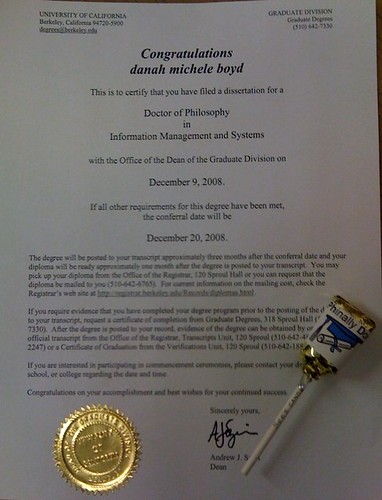When I wrote my dissertation, it didn’t dawn on me that using the Creative Commons license might be remotely controversial. There’s a template for dissertations at Berkeley and one of those pages is the copyright page. Initially, I edited the copyright page to match the CC license that Cory Doctorow uses in all of his books on the copyright page. Shortly before I was set to file, I talked to another grad student in my department who had just filed his dissertation. Much to my horror, I learned that he was the first student to file his dissertation at Berkeley under the Creative Commons license and that it had been a disaster. He went through many iterations before they accepted it, complete with the CC license as an Appendix. Not wanting to pick a fight, I copied his approach verbatim. I went to file my dissertation and hit a stumbling block. They told me they had never seen such a thing. I told them that Joe Hall had filed that way only a few months back. They told me that it would need approval from high up and that I’d have to wait a long time to get that approval. Frantic, I started texting and emailing Joe. Luckily, he had all of the emails on hand and forwarded them to me. As it turns out, the person that I was trying to file with as the one who filed Joe’s and when I showed her emails that she sent negotiating this process with Joe, she let me file. I suggested she might want to take note since there would be plenty more students like me and Joe.
Today, the Daily Cal ran a story about our adventures in filing. I was pleased to learn that the Dean of the Grad Division committed to making CC licenses available to students in the future. This is truly good news!
But I also want to make a plea to all of you grad students out there who are slaving away on your dissertations… Use Creative Commons. The forms you fill out when you file your diss under ProQuest encourage you to make sure to copyright your dissertation. While theft is part of the framing, it is also framed as being about you profiting off of doing so (and ProQuest brokering the sale of your diss). Realistically, 99% of all grad students are never going to see a dime directly from their dissertation. What’s the advantage of keeping “all rights reserved”? Why not let folks use it for whatever non-commercial purposes they deem fit (like teaching a chapter or two in class)? I mean… I would LOVE it if someone translated my dissertation. Or remixed it. Or turned it into a movie. That ain’t ever gonna happen, but still… why actively prevent it?
And while we’re at it… why not make it freely available? Part way through my dissertation, I realized that I had never read a dissertation. I was surprised to find that very few people make their dissertations easily available. Why? In some senses, the diss is quite embarrassing. It’s imperfect. You’re sick of it. But there are huge advantages to making it available. At the very least, it allows future students to get a sense of what they should expect. (There was nothing more nerve-calming than realizing that my mentors’ dissertations were totally sloppy at points.)
Anyhow, if you’re a student out there, consider licensing your dissertation under Creative Commons and making your diss freely available either on your website or through services like SSRN or arXiv. I’m sure that there are many others out there doing similar things, but perhaps our story and template can help you persuade your school to allow CC-licensed dissertations.
My dissertation: Taken Out of Context
Joe’s dissertation: Policy Mechanisms for Increasing Transparency in Electronic Voting

